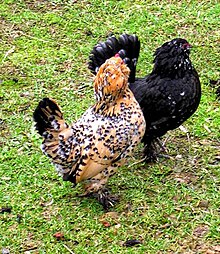The Barbu d'Uccle or Belgian d'Uccle,[7][8] Dutch: Ukkelse Baardkriel, is a Belgian breed of bearded bantam chicken. It was first bred in the town of Uccle on the outskirts of Brussels, in central Belgium, in the early years of the twentieth century. It is a true bantam, with no standard-sized large fowl counterpart, and is one of eleven Belgian true bantam breeds.
 A millefleur and a black mottled Barbu d'Uccle | |
| Conservation status | |
|---|---|
| Other names |
|
| Country of origin | Belgium |
| Standard | |
| Traits | |
| Weight | |
| Classification | |
| APA | feather legged[4]: 7 |
| EE | yes[5] |
| PCGB | Belgian bantam[6]: 65 |
| |

History
editThe Barbu d'Uccle was created by Michael Van Gelder of Uccle, Belgium, in the early years of the twentieth century,[9] with help and advice from Robert Pauwels and Louis Vander Snickt. It is thought, but not known for certain, that he cross-bred the existing Sabelpoot and Barbu d'Anvers bantam breeds. The Barbu d'Uccle was first shown in 1905.[9][7] The first colours were millefleurs and porcelain, but black, white and cuckoo were soon added; by 1909 the breed was well established.[10]: 52 The Barbu d'Uccle was first exported to the United Kingdom in 1911.[11] The millefleur variety was added to the Standard of Perfection of the American Poultry Association in 1914.[12] From that time, partly as a consequence of the First and Second World Wars, it gradually declined. A breed society, the Club belge du Barbu d’Uccle, was formed in 1969.[10]: 52
In the twenty-first century conservation status of the breed is listed as "critical";[2] it is nevertheless the third-most numerous true bantam breed in Belgium.[10]: 52
Characteristics
editThe Barbu d'Uccle has a low posture, a full beard and a muff; the legs are heavily feathered. It has a single comb, unlike the Barbu d'Anvers, which has a rose comb.[9]
In the Netherlands the recommended weight is 700–800 g for cock birds, and about 550 g for hens,[9] while the French standard recommends average weights of 750 g and 650 g respectively.[3] The Poultry Club of Great Britain suggests a weight in the range 790–910 g for males and 680–790 g for females.[6]: 68 The American standard specifies an ideal weight of 26 oz (740 g) for cocks, 22 oz (620 g) for hens and cockerels, and 20 oz (570 g) for pullets.[12]
Twenty-eight colour varieties are listed for the Barbu d'Uccle in Belgium.[10]: 52 Colours listed by the Entente Européenne include blue, blue quail, cuckoo, millefleur, porcelain, lavender, lavender quail, black, black mottled, silver quail, quail, and white.[5] The American Poultry Association lists seven varieties: black (1996), golden neck (1996), millefleur (1914), mottled (1996), porcelain (1965), self blue (1996), and white (1981).[4]: 7–8
References
edit- ^ Barbara Rischkowsky, D. Pilling (eds.) (2007). List of breeds documented in the Global Databank for Animal Genetic Resources, annex to The State of the World's Animal Genetic Resources for Food and Agriculture. Rome: Food and Agriculture Organization of the United Nations. ISBN 9789251057629. Accessed January 2017.
- ^ a b Breed data sheet: Ukkelse baardkriel / Belgium (Chicken). Domestic Animal Diversity Information System of the Food and Agriculture Organization of the United Nations. Accessed May 2020.
- ^ a b c [Bantam Club Français] (1994). Elevage sélection et standard des poules naines (in French). [S.l.] : Bantam Club Français.
- ^ a b APA Recognized Breeds and Varieties: As of January 1, 2012. American Poultry Association. Archived 4 November 2017.
- ^ a b Liste des races et variétés homologuée dans les pays EE (28.04.2013). Entente Européenne d’Aviculture et de Cuniculture. Archived 16 June 2013.
- ^ a b Victoria Roberts (2008). British poultry standards: complete specifications and judging points of all standardized breeds and varieties of poultry as compiled by the specialist breed clubs and recognised by the Poultry Club of Great Britain. Oxford: Blackwell. ISBN 9781405156424.
- ^ a b Brief History: Belgian d'Uccle and Booted Bantam. Belgian d'Uccle & Booted Bantam Club (United States). Archived 25 June 2012.
- ^ [s.n.] (2011). Australian Poultry Standards, second edition. Ballarat, Victoria: Victorian Poultry Fanciers Association Ltd. ISBN 9781921488238.
- ^ a b c d Barbu d'Uccle. Zeldzame oorspronkelijke Belgische krielhoenderrassen. Archived 27 May 2007.
- ^ a b c d N. Moula, M. Jacquet, A. Verelst, N. Antoine-Moussiaux, F. Farnir, P. Leroy (2012). Les races de poules belges (in French). Annales de Médecine Vétérinaire 156: 37–65. Accessed August 2014.
- ^ Chickens: True Bantam. Poultry Club of Great Britain. Archived 11 November 2018.
- ^ a b Pam Percy (2006). The Field Guide to Chickens. St. Paul, Minnesota: Voyageur Press. ISBN 9781610600781.